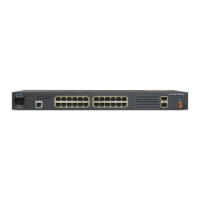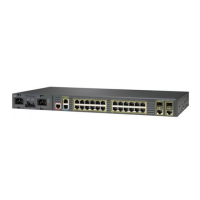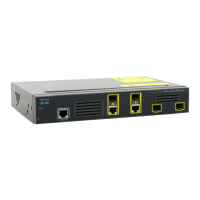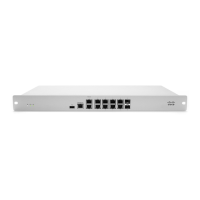36-21
Cisco ME 3400 Ethernet Access Switch Software Configuration Guide
OL-9639-07
Chapter 36 Configuring IPv6 Unicast Routing
Configuring IPv6
To disable an OSPF routing process, use the no ipv6 router ospf process-id global configuration
command. To disable the OSPF routing process for an interface, use the no ipv6 ospf process-id area
area-id interface configuration command.
For more information about configuring OSPF routing for IPv6, see the “Implementing OSPF for IPv6”
chapter in the Cisco IOS IPv6 Configuration Library on Cisco.com.
Step 3
area area-id range {ipv6-prefix/prefix length}
[advertise | not-advertise] [cost cost]
(Optional) Consolidate and summarize routes at an area
boundary.
• area-id—Identifier of the area about which routes are to be
summarized. It can be specified as either a decimal value or
as an IPv6 prefix.
• ipv6-prefix/prefix length—The destination IPv6 network and
a decimal value that shows how many of the high-order
contiguous bits of the address comprise the prefix (the
network portion of the address). A slash mark (/) must
precede the decimal value.
• advertise—(Optional) Set the address range status to
advertise and to generate a Type 3 summary link-state
advertisement (LSA).
• not-advertise—(Optional) Set the address range status to
DoNotAdvertise. The Type 3 summary LSA is suppressed,
and component networks remain hidden from other
networks.
• cost cost—(Optional) Metric or cost for this summary route,
which is used during OSPF SPF calculation to determine the
shortest paths to the destination. The value can be 0 to
16777215.
Step 4
maximum paths number-paths (Optional) Define the maximum number of equal-cost routes to
the same destination that IPv6 OSPF should enter in the routing
table. The range is from 1 to 64, and the default is 16 paths.
Step 5
exit Return to global configuration mode.
Step 6
interface interface-id Enter interface configuration mode, and specify the Layer 3
interface to configure.
Step 7
ipv6 ospf process-id area area-id [instance
instance-id]
Enable OSPF for IPv6 on the interface.
• instance instance-id—(Optional) Instance identifier.
Step 8
end Return to privileged EXEC mode.
Step 9
show ipv6 ospf [process-id] [area-id] interface
[interface-id]
or
show ipv6 ospf [process-id] [area-id]
Display information about OSPF interfaces.
Display general information about OSPF routing processes.
Step 10
copy running-config startup-config (Optional) Save your entries in the configuration file.
Command Purpose

